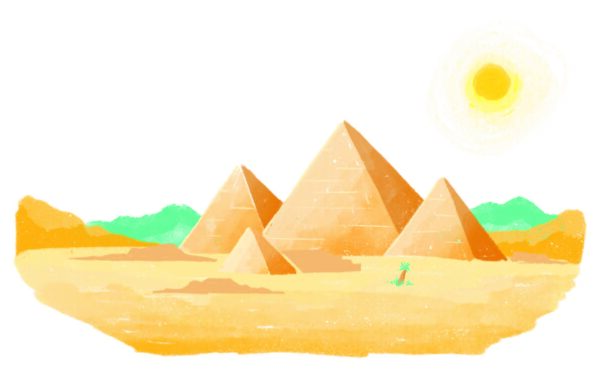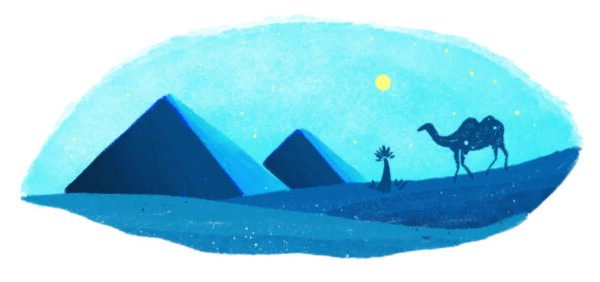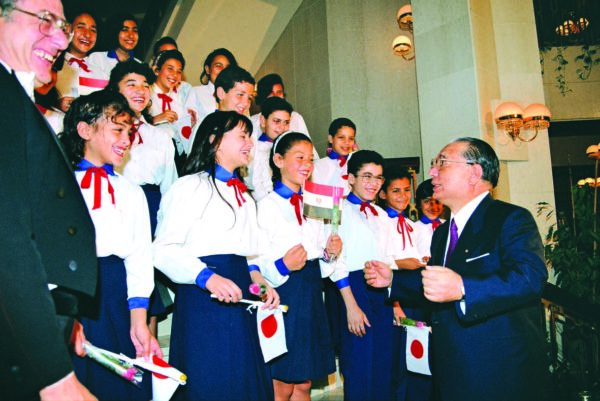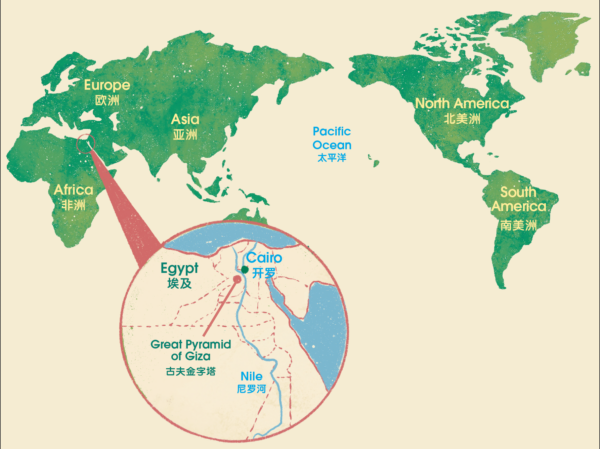Towards 2030 2
16日 5月, 2025年
8 Min(s)
16日 5月, 2025年

Autumn is harvest season. The golden fields of rice are ready for reaping. Each year’s crop is produced through the farmers’ painstaking care and effort. Each and every day, they spend their precious time growing and tending the rice, vegetables and fruit that we eat to sustain our lives.
The African continent is home to towering stone structures that people also spent their precious time to build over an extremely long period. These are the pyramids of Giza in Egypt, which were believed to be built as the tombs of ancient pharaohs or kings. The largest pyramid – known as the Pyramid of Khufu – is 147 metres (482 feet) high and 230 metres (754 feet) long at the base on each side. It was estimated to be made of 2.3 million stone blocks, each weighing about 2.5 tonnes.
One of the greatest historians of the 20th century, Dr Arnold J. Toynbee (1889–1975), with whom I published a dialogue, has written that the pyramids “will survive for hundreds of thousands of years to come. It is not inconceivable that they may outlast (humankind itself).”

I first saw the pyramids on my visit to Egypt in 1962. I travelled to the country again, 30 years later, in June 1992, when I was invited there to participate in a number of cultural events. The pyramids hadn’t changed a bit. Rising high above the desert, they remained as regal as ever. I could see a camel nearby carrying someone on its back, and in the far distance, modern buildings dotting the skyline.
I wondered what the pyramids must have been thinking as they watched over us all these centuries. In an expression of deep admiration for them, I pointed my camera in their direction and took a photo.
* * * * *
The sun is beating down, and not far from the stately pyramid before me,
I can hear a murmur from one of the few trees standing.

“I’m so thirsty!” it complains. “If only it would rain! Then, I’d surely grow and grow, and quickly become so tall that everyone would look up at me in awe!”
The pyramid gives a slow chuckle, and says: “There’s no need to be in such a hurry! It’ll rain eventually.”
“But I don’t like waiting!” exclaims the tree, pouting. “I want to grow tall as soon as I can! There’s no way I can wait as patiently as you!”
Puzzled by the tree’s impatience, the pyramid remarks: “Well, it’s quite important for you to sink your roots deep, store up nourishment, and build a thick, strong trunk. Otherwise, you’ll just snap in half when the next sandstorm hits.”
Considering this for a moment, the tree says: “Come to think of it, you are always smiling – even on days when it’s scorching hot or when blinding sandstorms are raging … How long have you been here, anyway?”
Gazing off into the distance, the pyramid replies: “Let me see … For about 4,600 years.”
“What!? 4,600 years?” The tree is astonished.

The pyramid continues: “A great number of people came together to build me, transporting incredibly heavy stone blocks and piling them up carefully, one on top of the other. It was a long time ago, so I’m not quite sure I remember correctly, but I think it took them decades.”
“Decades! Really?” the tree shakes its leaves in surprise. “So you’ve been able to stand here so solidly for 4,600 years because they took the time to build you with great care and effort! And here I was thinking that it’s always better to do things as quickly as possible.”
The pyramid nods sagely: “Things that are hastily built are also quick to crumble, but things that are built with care and painstaking effort do not fall apart so easily. For many years, people said that I was built by slaves through forced labour. But recent discoveries indicate that I was actually built by teams of people who were called ‘Friends of the King.’ I believe I have survived to this day without collapsing and will remain here always, precisely because I was built with care by groups of friends. And I’m very grateful for that.”
Looking up at the pyramid, the tree then says: “I’m going to join together with the other trees around me and, as we encourage one another, try even a little bit each day to sink my roots deeper and to strengthen my trunk.”
The pyramid replies happily: “You may be small, but you’re a treasure here in the middle of the desert. You have the power to revitalise and refresh people who come to rest in your shade. Trees can also grow and multiply – even I don’t have the power to do that! So lift your head up high and be confident!”

“I will!” the tree says, smiling and bowing in appreciation. “It may take time, but I’m determined to grow into a tall, strong tree, so please continue to watch over me!”
“It would be my pleasure!” the pyramid says, delighted. “You’ve given me something new to look forward to!”
A camel who was listening to their conversation turns its gaze towards them and says: “Many friends from around the world have come to visit you here again today. Because I can move about, I’ll do my best to work twice as hard for the both of you!”
High in the sky above the desert, the moon begins to shine with a smile.

* * * * *
Some of you may wish there was a fast, easy way for you to become good at schoolwork or sports. Some of you may even compare yourselves to others and think that you can never be as good as them. However, I would like you to know that as long as you take your time and make steady, consistent efforts towards your goal, you are certain to see genuine improvement.
For example, if you set aside just 15 minutes every morning for reading a book, after four days you will have spent an hour reading. In a month, that will
amount to seven and a half hours, and in a year, three days and 19 hours. Eventually, you will get used to reading and it won’t be so hard for you anymore. The same is true of our daily efforts to do gongyo and chant Nam-myoho-renge-kyo.
In Japanese, pyramids are referred to as golden towers (Jpn. kinjito), meaning a monumental achievement that will endure forever. I have striven together with my fellow Soka Gakkai members, including many of your parents, to create magnificent “pyramids of encouragement” – a network built through supporting and inspiring one person after another – throughout Japan and the world. There were those who looked down on us, saying that such efforts wouldn’t change anything.
Today, however, we have members in 192 countries and territories earnestly working for world peace and the happiness of humanity. And I pray and have confidence that you will build all kinds of even more wonderful “pyramids” – enduring achievements – in the future.
I hope you will start by setting goals for yourself and working bit by bit towards their realisation. For example, you could try going to bed a little earlier, and then waking up earlier and taking time to eat breakfast. You could also try doing gongyo and chanting every day, or setting aside time for schoolwork and reading.
Please continue challenging yourself and making steady efforts with patience and perseverance. May you all boldly create great new “pyramids” of brilliant achievement!
* * * * *

Egypt flourished as the cradle of civilisation for thousands of years. While a majority of its land area is desert, the Nile, the world’s longest river, flows through it, and many pyramids have been discovered along the river’s banks.
Mr Ikeda visited Egypt on two occasions, in 1962 and 1992. He has also met with a number of noted leaders who are originally from Egypt, such as United Nations Secretary-General Boutros Boutros-Ghali and Egyptian Minister of Culture Farouq Hosni.
He has also published a number of dialogues on the topic of Buddhism and Islam – Islam being the dominant religion of Egypt and its neighboring countries in the Middle East. These include Global Civilisation: A Buddhist-Islamic Dialogue, with Iranian-born peace scholar Majid Tehranian; A Passage to Peace: Global Solutions from East and West, with Harvard professor of social anthropology and Middle Eastern studies Nur Yalman; and The Wisdom of Tolerance: A Philosophy of Generosity and Peace, with former Indonesian president Abdurrahman Wahid.
In addition, institutes founded by President Ikeda have been actively promoting dialogue among religions and civilisations in order to foster friendship and understanding. These include the Institute of Oriental Philosophy (IOP); the Toda Peace Institute; and the Ikeda Centre for Peace, Learning and Dialogue.
From SGI Newsletter No. 10094
